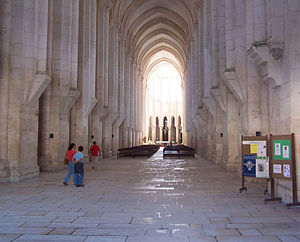
Back Romano-Gotik German Gótico inicial Spanish Romanogotyk Frisian Protogotico Italian Romanogotiek Dutch

Romano-Gothic is a term, rarely used in writing in English, for an architectural style, part of Early Gothic architecture, which evolved in Europe in the 12th century from the Romanesque style, and was an early style in Gothic architecture. In England "Early English Gothic" remains the usual term. The style is characterized by rounded and pointed arches on a vertical plane. Flying buttresses were used, but are mainly undecorated. Romanesque buttresses were also used. Romano-Gothic began to use the decorative elements of Gothic architecture, but not the constructional principles of more fully Gothic buildings. However, the walls did start to become thinner by using some pointed arches and ribbed vaults to distribute weight more evenly. [1]
Combining ribbed vaults and the Romanesque tradition, the cathedrals of Angers (1149–1159) and Poitiers (1162) are examples of a transitional Gothic style, more austere and less well lit. Especially in Germany and the Low Countries, the term is used of relatively late buildings in a cautious provincial version of Gothic. The late-Romanesque style of the Rhineland has often been called Romano-Gothic.[2]
- ^ Smith, Hillary. "Gothic Cathedrals: Architecture & Divine Light". World History Encyclopedia. Retrieved 2023-04-29.
- ^ "History & styles: Romano-Gothicism (ca. 1250-ca. 1350)". www.archimon.nl. Retrieved 2023-04-29.